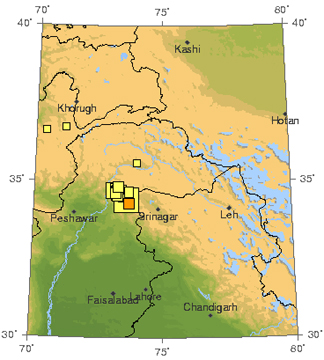Geotimes

Untitled Document

Web Extra
Monday, October 10, 2005
Kashmir earthquake
 A magnitude-7.6 earthquake
shook the Kashmir region, which is shared by India and Pakistan, on Saturday
morning, Oct. 8. In the hours and days that followed, more than a dozen major
aftershocks continued to shake the region, including a magnitude-6.2 event two
hours after the main temblor.
A magnitude-7.6 earthquake
shook the Kashmir region, which is shared by India and Pakistan, on Saturday
morning, Oct. 8. In the hours and days that followed, more than a dozen major
aftershocks continued to shake the region, including a magnitude-6.2 event two
hours after the main temblor.
A magnitude-7.6 earthquake (the largest
yellow square in the image to the right, from 4 p.m. universal time on Oct.
10) shook Pakistan on on Saturday morning, killing more than 20,000 people in
the Kashmir region. Aftershocks followed, including one magnitude 6.2 and many
larger than magnitude 5 (some are represented here by smaller yellow boxes).
Image is courtesy of U.S. Geological Survey.
As rescue workers finally arrived at remote villages in Kashmir's Himalayan
mountains on Monday, the reported death toll surpassed 20,000 people. Only handfuls
of survivors have been pulled from the rubble so far, according to The
New York Times. Local people are struggling to remove rubble with their
hands and pickaxes, insufficient against concrete and other building materials,
according to National Public Radio. In the meantime, communities
lack basic needs such as water, food and shelter, as they wait for help from
the government. In many places, help did not arrive until today, and others
have yet to receive military or other assistance.
In Kashmir's capital of Muzaffarabad, about 10 kilometers (6.2 miles) southwest
of the epicenter of the main earthquake, looting broke out on Monday, according
to Reuters. Responders and locals are anticipating that
they will have shortages in medicine, in addition to food, water, and shelter.
In many Kashmir villages, earthquake-triggered landslides and mudslides funneled
down tight valleys, causing houses to slide down hillsides and crush others
below. "Not only do they have the problems of Iran or Afghanistan —
[large] earthquakes and mud homes — but they are located in northern Pakistan
in very narrow steep canyons," says Brian Tucker of GeoHazards
International, an organization that works to bring earthquake-safe-building
practices to hazardous regions, particularly to schools, which were hard hit
in this event. "They live at the bottom of these very, very steep canyons,
so that earthquake-triggered landslides are common."
Tucker recalls seeing buildings that were unscathed by earthquake shaking but
damaged by subsequent landslides, while flying over the region by helicopter
in 2000. He says that "no one should think that a new edition of a building
code is going to make a difference." The country also needs more people
with the knowhow to make and enforce such codes. In contrast to the number of
earth scientists and engineers in Iran and Turkey, for example, he says that
Pakistan has a dearth of such professionals.
For the immediate response to this most recent disaster, Pakistan's president
Musharraf accepted direct assistance from foreign earthquake response teams,
in addition to financial assistance from several countries (various countries'
embassies offered funds), including the United States. President Bush offered
$50 million and several helicopters.
India's offer of assistance remains delicate, as the two countries have had
rocky relations over ownership of the Kashmir region. Reports of deaths from
the Indian side of Kashmir remain in the hundreds (around 865, according to
The New York Times), though news reports have speculated
that those numbers will rise if emergency response teams can eventually get
to the region, which is heavily patrolled by India's military and has experienced
internal violence between Muslims and Hindus.
The Kashmir region is extremely tectonically active. The collision of the Indian
subcontinent into Eurasia — traveling north at the fast pace of 40 millimeters
(1.6 inches) a year — formed the major and active thrust faults in the
region, which consistently rupture in large earthquakes.
Naomi Lubick
Links:
National
Public Radio
Reuters
U.S.
Geological Survey earthquake event report (as of 10-10-05)
The New York Times (may require login)
International
Herald Tribune
GeoHazards
International
Back to top
Untitled Document

 A magnitude-7.6 earthquake
shook the Kashmir region, which is shared by India and Pakistan, on Saturday
morning, Oct. 8. In the hours and days that followed, more than a dozen major
aftershocks continued to shake the region, including a magnitude-6.2 event two
hours after the main temblor.
A magnitude-7.6 earthquake
shook the Kashmir region, which is shared by India and Pakistan, on Saturday
morning, Oct. 8. In the hours and days that followed, more than a dozen major
aftershocks continued to shake the region, including a magnitude-6.2 event two
hours after the main temblor. 
